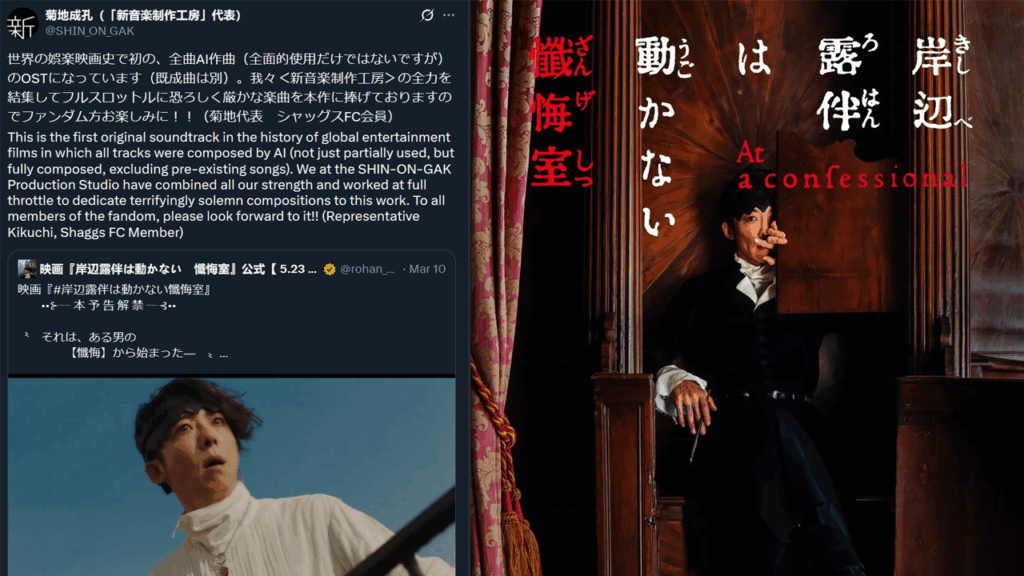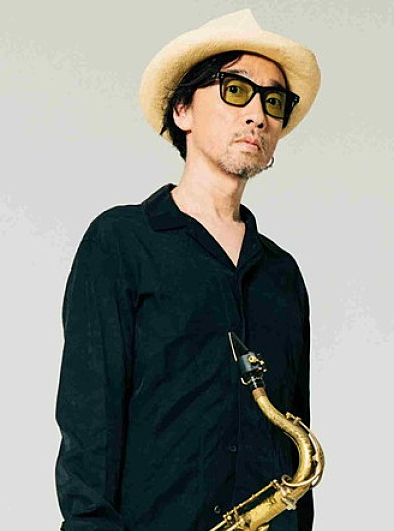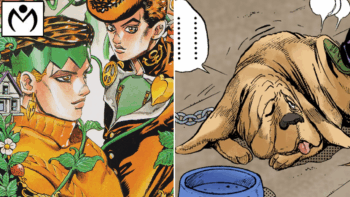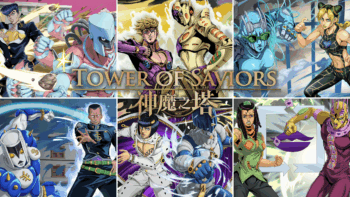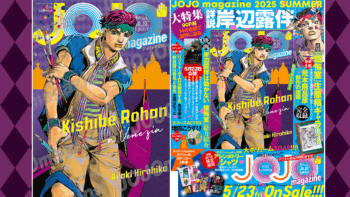Back in March 2025, the composer of the Thus Spoke Kishibe RohanThus Spoke Kishibe Rohan (TV Drama) Thus Spoke Kishibe Rohan is a live-action mini-series based on the manga series of the same name by Hirohiko Araki. It was produced by and aired on Japan's national broadcaster NHK from December 2020 to May 2024. Rohan Kishibe is a famous, arrogant, and eccentric manga artist whose Pink Dark... TV drama and films, Naruyoshi KikuchiNaruyoshi Kikuchi
Thus Spoke Kishibe Rohan is a live-action mini-series based on the manga series of the same name by Hirohiko Araki. It was produced by and aired on Japan's national broadcaster NHK from December 2020 to May 2024. Rohan Kishibe is a famous, arrogant, and eccentric manga artist whose Pink Dark... TV drama and films, Naruyoshi KikuchiNaruyoshi Kikuchi Naruyoshi Kikuchi is a Japanese composer, songwriter, band leader, university lecturer, and music producer known for his work on various films and television shows. He performs music on saxophone and electronic keyboard as well as singing and rapping. He has composed the soundtracks for NHK's television adaptation of Thus Spoke..., posted that the soundtrack for the At a ConfessionalAt a Confessional (Film)
Naruyoshi Kikuchi is a Japanese composer, songwriter, band leader, university lecturer, and music producer known for his work on various films and television shows. He performs music on saxophone and electronic keyboard as well as singing and rapping. He has composed the soundtracks for NHK's television adaptation of Thus Spoke..., posted that the soundtrack for the At a ConfessionalAt a Confessional (Film) Thus Spoke Kishibe Rohan: At a Confessional is a live-action movie adaptation of the one-shot At a Confessional, based on the Thus Spoke Kishibe Rohan TV drama series by NHK. It was officially announced on January 6, 2025, and is scheduled to release in Japanese theaters on May 23, 2025.... film was fully composed by artificial intelligence, aside from pre-existing tracks. Starring Issey TakahashiIssey Takahashi
Thus Spoke Kishibe Rohan: At a Confessional is a live-action movie adaptation of the one-shot At a Confessional, based on the Thus Spoke Kishibe Rohan TV drama series by NHK. It was officially announced on January 6, 2025, and is scheduled to release in Japanese theaters on May 23, 2025.... film was fully composed by artificial intelligence, aside from pre-existing tracks. Starring Issey TakahashiIssey Takahashi Issey Takahashi is a Japanese actor and singer credited for his role in the Thus Spoke Kishibe Rohan TV drama and two films, Rohan au Louvre and At a Confessional, as the lead character, Rohan Kishibe. He also plays Nizaemon Yamamura in the former film. Takahashi is also known for... as Rohan KishibeRohan Kishibe
Issey Takahashi is a Japanese actor and singer credited for his role in the Thus Spoke Kishibe Rohan TV drama and two films, Rohan au Louvre and At a Confessional, as the lead character, Rohan Kishibe. He also plays Nizaemon Yamamura in the former film. Takahashi is also known for... as Rohan KishibeRohan Kishibe Rohan Kishibe is a primary ally featured in the fourth part of the JoJo's Bizarre Adventure series, Diamond is Unbreakable. He is introduced as an antagonist in the "Let's Go to the Manga Artist's House" story arc, but later becomes an ally and cooperates in the search for Yoshikage Kira...., At a Confessional is now airing in theaters in Japan as of May 23, 2025. The film is based on Hirohiko ArakiHirohiko Araki
Rohan Kishibe is a primary ally featured in the fourth part of the JoJo's Bizarre Adventure series, Diamond is Unbreakable. He is introduced as an antagonist in the "Let's Go to the Manga Artist's House" story arc, but later becomes an ally and cooperates in the search for Yoshikage Kira...., At a Confessional is now airing in theaters in Japan as of May 23, 2025. The film is based on Hirohiko ArakiHirohiko Araki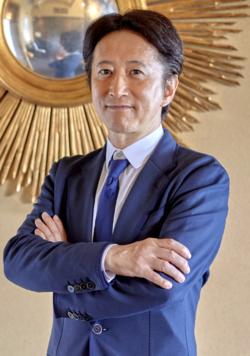 Hirohiko Araki, born Toshiyuki Araki, is a Japanese manga artist and the author of JoJo's Bizarre Adventure. He made his debut in 1980 with his one-shot Poker Under Arms, and began his professional career with the short series Cool Shock B.T., Baoh the Visitor, and Gorgeous Irene. Araki's biggest series,...‘s spin-off of the JoJo’s Bizarre AdventureJoJo's Bizarre Adventure
Hirohiko Araki, born Toshiyuki Araki, is a Japanese manga artist and the author of JoJo's Bizarre Adventure. He made his debut in 1980 with his one-shot Poker Under Arms, and began his professional career with the short series Cool Shock B.T., Baoh the Visitor, and Gorgeous Irene. Araki's biggest series,...‘s spin-off of the JoJo’s Bizarre AdventureJoJo's Bizarre Adventure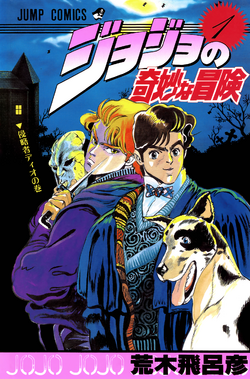 JoJo's Bizarre Adventure, commonly shortened to JoJo, is an ongoing shonen and seinen manga written and illustrated by Hirohiko Araki since December 1986. The story spans nine parts, each following a different protagonist from the Joestar bloodline, with new settings and eras introduced in every installment. JoJo's Bizarre Adventure was originally serialized... series, Thus Spoke Kishibe RohanThus Spoke Kishibe Rohan
JoJo's Bizarre Adventure, commonly shortened to JoJo, is an ongoing shonen and seinen manga written and illustrated by Hirohiko Araki since December 1986. The story spans nine parts, each following a different protagonist from the Joestar bloodline, with new settings and eras introduced in every installment. JoJo's Bizarre Adventure was originally serialized... series, Thus Spoke Kishibe RohanThus Spoke Kishibe Rohan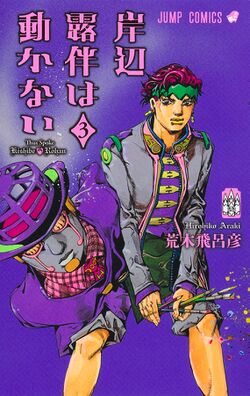 Thus Spoke Kishibe Rohan, also called the Rohan Kishibe Series, is an ongoing series of one-shot manga featuring the titular character, Rohan Kishibe, as the narrator and/or protagonist. These one-shots are intermittently published in various magazines, including Weekly Shonen Jump, Ultra Jump, and Jump Square. A paperback volume compiling the.... At a ConfessionalTSKR Episode 16
Thus Spoke Kishibe Rohan, also called the Rohan Kishibe Series, is an ongoing series of one-shot manga featuring the titular character, Rohan Kishibe, as the narrator and/or protagonist. These one-shots are intermittently published in various magazines, including Weekly Shonen Jump, Ultra Jump, and Jump Square. A paperback volume compiling the.... At a ConfessionalTSKR Episode 16
The composer previously dabbled with using AI compositions in 2022 and 2023 for two tracks used in the “Rock-Paper-Scissors Kid”TSKR Episode 8 (TV Drama) Rock-Paper-Scissors Kid is the eighth episode of NHK's Thus Spoke Kishibe Rohan TV drama series, released on December 27, 2022. It adapts the "Rock-Paper-Scissors Kid is Coming!" story arc from Diamond is Unbreakable. Rohan Kishibe meets Ken Oyanagi, a young boy obsessed with the game rock-paper-scissors who constantly challenges Rohan... episode and Rohan au LouvreRohan au Louvre (Film)
Rock-Paper-Scissors Kid is the eighth episode of NHK's Thus Spoke Kishibe Rohan TV drama series, released on December 27, 2022. It adapts the "Rock-Paper-Scissors Kid is Coming!" story arc from Diamond is Unbreakable. Rohan Kishibe meets Ken Oyanagi, a young boy obsessed with the game rock-paper-scissors who constantly challenges Rohan... episode and Rohan au LouvreRohan au Louvre (Film) Rohan au Louvre, titled Rohan at the Louvre in its English release, is a live-action movie adaptation of the one-shot Rohan au Louvre, based on the Thus Spoke Kishibe Rohan TV drama series by NHK. It was officially announced on January 4, 2023 and released in Japanese theaters on May... film, “A Horror Film Produced by AI” and “Simultaneous Performance of Two String Quartets Produced by AI“. Kikuchi used the software “Max” (more specifically, “OMax”) for those two tracks, developed by the company Cycling ’74. Max isn’t like a typical prompt-based generative AI tool. Users program their own generative systems and instruments, with the software using pattern recognition and custom algorithms to generate music. The software improvises using material from pre-recorded scores or live human contributions, processing voice samples with electronic techniques. Kikuchi produced “Simultaneous Performance of Two String Quartets” in a call-and-response format with two instances of Max. One instance, Max (A), generated music, and the other instance, Max (B), responded to it. [Source]
Rohan au Louvre, titled Rohan at the Louvre in its English release, is a live-action movie adaptation of the one-shot Rohan au Louvre, based on the Thus Spoke Kishibe Rohan TV drama series by NHK. It was officially announced on January 4, 2023 and released in Japanese theaters on May... film, “A Horror Film Produced by AI” and “Simultaneous Performance of Two String Quartets Produced by AI“. Kikuchi used the software “Max” (more specifically, “OMax”) for those two tracks, developed by the company Cycling ’74. Max isn’t like a typical prompt-based generative AI tool. Users program their own generative systems and instruments, with the software using pattern recognition and custom algorithms to generate music. The software improvises using material from pre-recorded scores or live human contributions, processing voice samples with electronic techniques. Kikuchi produced “Simultaneous Performance of Two String Quartets” in a call-and-response format with two instances of Max. One instance, Max (A), generated music, and the other instance, Max (B), responded to it. [Source]
On the other hand, with the exception of pre-existing tracks, Kikuchi and his SHIN-ON-GAK production studio used prompt-based generative AI to compose the soundtrack of At a Confessional. According to the X biography of one of the members in the group, Hizuru Saito, websites such as Suno or Stable Audio were likely involved.
Naruyoshi Kikuchi’s Statement on X
This is the first original soundtrack in the history of global entertainment films in which all tracks were composed by AI (not just partially used, but fully composed, excluding pre-existing songs). We at the SHIN-ON-GAK Production Studio have combined all our strength and worked at full throttle to dedicate terrifyingly solemn compositions to this work. To all members of the fandom, please look forward to it!! (Representative Kikuchi, Shaggs FC Member)
Interview in the At a Confessional Pamphlet
The pamphlet for the film sold at theaters includes an interview with Kikuchi. He proudly admitted that he did not compose a single track in the film himself.
In this work, it seems that all the new music was produced by AI.
Kikuchi: The Thus Spoke Kishibe Rohan series is a proud entertainment production, and we had no intention of conducting any kind of art-leaning musical experiment. However, while remaining firmly within the realm of entertainment, I’ve personally made it a mission to incorporate at least one musical technique in each installment that has never been tried before in entertainment music.
The history of Thus Spoke Kishibe Rohan also overlaps with the development of the group I founded, SHIN-ON-GAK Production Studio, and synchronizes with the rapid evolution of generative AI. For example, in Episode 8 of Season 3 of the drama series, “Rock-Paper-Scissors Kid,” there was already one track composed entirely by AI.
With the current level of generative AI technology, it’s now possible to create music that sounds as if it were performed and sung by humans, ranging from full orchestras to ethnic music, and even vocal-included soundtracks.
For this production, I didn’t show the visuals to the members of the studio. All I told them was that it was a work titled Thus Spoke Kishibe Rohan: At a Confessional and that it was “shot entirely on location in Venice.” Just with that information alone, around 50 tracks were generated over the course of three days. Even without giving detailed imagery, you can still generate music in a reasonably usable state—and in fact, having a bit of mismatch can actually be a good thing.
If you simply input the term “orchestra,” the AI will produce a perfectly fitting piece that could play in the climax of a movie where two lovers embrace. By intentionally withholding content details and limiting information to a minimum, we selected tracks that seemed usable and handed them over to Director Kazutaka WatanabeKazutaka Watanabe Kazutaka Watanabe is a Japanese producer, director, and scriptwriter credited for his work as the director of the Thus Spoke Kishibe Rohan TV drama and Rohan au Louvre film, as well as the upcoming At a Confessional film. Kazutaka Watanabe was born in Fuji, Shizuoka in 1969. Watanabe was an....
Kazutaka Watanabe is a Japanese producer, director, and scriptwriter credited for his work as the director of the Thus Spoke Kishibe Rohan TV drama and Rohan au Louvre film, as well as the upcoming At a Confessional film. Kazutaka Watanabe was born in Fuji, Shizuoka in 1969. Watanabe was an....
Among them was a choral piece that resembled pseudo-church music. It was of such high quality that you wouldn’t think it was AI-composed, and it matched the tone of the work extremely well.
As a result, for this project, I did not compose a single piece myself.
What left the strongest impression when I first heard the soundtrack was the cold, terrifying atmosphere that evokes a “shadow of death” hanging over Venice. The frequent use of opera also stood out.
Kikuchi: There’s a scene in this work where Rigoletto plays, but for the background score, we intentionally incorporated choral music that isn’t classically European—songs with wavering tones. I thought it was interesting that, for the Thus Spoke Kishibe Rohan series, a solemn piece not in Japanese would be playing, which hadn’t happened before.
In the end, Director Watanabe ended up choosing a number of tracks that included vocals. Eerie choral music is a classic staple of horror films, and I think its effect was especially striking this time as well.
With AI composition, hallucinatory elements such as things that wouldn’t exist in reality can be added. As a result, I felt the music became not only solemn, but also alternative and thrilling in its final form.
The scene where Tamiya points the gun at his own chin was striking for its intense industrial music.
Kikuchi: Yes. That sound matched extremely well with the gothic worldview and the intricately crafted, distinctive atmosphere of the Thus Spoke Kishibe Rohan series. The idea of electronica resounding through the organic cityscape of Venice might be something anyone would imagine at least once. In reality, industrial sounds are widely used across genres like games and horror films.
However, I see the AI-generated church music this time as a kind of “new cyberpunk.” If we had gone for a live recording by bringing in real singers from Europe capable of performing sacred music, that would have simply been a display of authenticity. But to have AI generate “industrial-church music,” where everything sounds mechanical, and then use it as a film score—that’s a musically near-futuristic, sci-fi approach, in my view.
Once again, can you tell us what point you focused on most in the soundtrack for this production?
Kikuchi: All of the pieces for At a Confessional are without exception of high quality, and their alignment with the scenes is excellent. More than anything, the music itself is truly frightening. That was very important. Because, even if the visuals are terrifying, in many works the music is merely “scary-sounding”. There are actually a lot of productions like that, where they just use unpleasant noise or throw in a few sound effects and call it a day.
But this time, thanks to AI, we were able to create genuinely terrifying music, including hymns and eerily indescribable vocal pieces. The newly composed songs in particular carry a strangeness that makes you wonder, “Could a human even sing this…?” There’s a kind of unease and eeriness imbued in them, different types of fear packed in all at once.
In Rohan au Louvre, the music leaned romantic, with emotional elements intended to elevate the saga of the entire series. In contrast, this time, we focused completely on the theme of fear and crafted the music accordingly with full intensity.
Hirohiko Araki’s Thoughts on AI
In Hirohiko Araki’s book, Hirohiko Araki’s New Manga TechniquesHirohiko Araki's New Manga Techniques Hirohiko Araki's New Manga Techniques: How to Create a Villain is a book written by Hirohiko Araki released on November 15, 2024. It is a sequel to the book Hirohiko Araki's Manga Techniques, in which Araki discusses the "golden path" to creating manga more in-depth. It was originally titled Hirohiko..., released on November 15, 2024, Araki wrote his thoughts on AI. He is against those who use AI-generated pieces for copying the artstyles of others to create manga, calling them con artists. On the other hand, he sees the benefits in AI for doing tasks that are tedious for humans to do manually.
Hirohiko Araki's New Manga Techniques: How to Create a Villain is a book written by Hirohiko Araki released on November 15, 2024. It is a sequel to the book Hirohiko Araki's Manga Techniques, in which Araki discusses the "golden path" to creating manga more in-depth. It was originally titled Hirohiko..., released on November 15, 2024, Araki wrote his thoughts on AI. He is against those who use AI-generated pieces for copying the artstyles of others to create manga, calling them con artists. On the other hand, he sees the benefits in AI for doing tasks that are tedious for humans to do manually.
That said, I haven’t completely excluded digital tools. Digital tools are just another resource for drawing manga. For instance, when my assistants work on backgrounds, they’ll often use software to process photos I’ve taken. But if left purely digital, those parts feel a bit lifeless and lack depth, so we always add a human touch to the finish. However, as AI advances, such issues will likely be eliminated, leaving fewer areas that need manual refinement. As a tool, I hope digital technology keeps progressing, potentially even reaching its peak someday.
Even if we get there, though, it’s not like people should stop drawing by hand. Digital tools may be convenient, but they’re ultimately just tools, and it’s invaluable to have the skill to use them well. You can often tell when someone lacks drawing fundamentals, no matter how capable the software might seem. In music, I’ve heard that there’s a noticeable quality difference between those who can play instruments and those who rely solely on programming; I believe the same applies here. Also, since scammers can easily exploit digital art, the ability to draw analog is an important way to recognize authenticity.
Hirohiko Araki – Hirohiko Araki’s New Manga Techniques
Reception
As expected, some fans in Japan are furious upon learning about this. A couple stated their intent to boycott the film, though there are also a few who are defending it.
I was pretty outraged to read Naruyoshi Kikuchi’s comment in the pamphlet saying that all the music for Thus Spoke Kishibe Rohan: At a Confessional was made using generative AI and that he didn’t compose anything at all. It goes against Araki-sensei’s intent, and the whole ‘just throw it at AI’ approach is really disappointing.
@nu_ya33
Thus Spoke Kishibe Rohan: At a Confessional (and Rock-Paper-Scissors Kid too) apparently used generative AI for the soundtrack lol. The real Rohan would probably be absolutely furious, given how obsessed he is with authenticity.
@mop_cat_lover
Ugh, I wanted to watch At a Confessional but now my motivation’s gone. Why would you use generative AI for the music? Of all things, this is Rohan Kishibe we’re talking about… Have you even read the original? Watched the drama? If Rohan found out, wouldn’t he fly into a raging fury?
@BLVS_AT
Learning that At a Confessional used generative AI for its soundtrack completely killed my interest in watching it…
@suzume_t
Saying ‘We composed the entire At a Confessional OST with AI!’ is the same as shamelessly profiting off someone else’s name. It’s gross, and honestly, I wish people like that didn’t exist.
@teneno22
Anti-AI people are selectively quoting only part of Araki-sensei’s words to make it seem as if he is against the use or development of AI, using that to criticize the music in Thus Spoke Kishibe Rohan: At a Confessional. That, in itself, is disrespectful to the author and amounts to tarnishing his name.
@kinugoshisuki
Isn’t this bad? You’re basically saying ‘We cut corners on the music production for a screen adaptation of a beloved work.’ Shouldn’t the proper approach be to choose from music that a human composer created with intention, after understanding the feel and message of the original work? Generative AI skips all of that. At best, you’re just picking a genre.
@citrulritro
Thus Spoke Kishibe Rohan is using generative AI, so I’ve canceled my plans to go see it. Why would I ever want to pay money to see a film that throws away its own value?
@0_0_0_2016
The Rohan Kishibe series has always had Naruyoshi Kikuchi in charge of the music, including this time as well, but apparently this is a first-of-its-kind attempt. To be honest, I do feel uneasy about it too, but knowing Kikuchi, I believe he’s fully engaging with the coming wave of AI-generated music and probably putting in even more effort than he would for conventional composition. That’s just my personal opinion, though.
@gillgazachan
In response to the last tweet above, Kikuchi stated the following.
Of course that’s obvious, lol. We’re fighting against idiots who don’t know anything yet assume we used AI out of laziness. The world is filled with anxiety, and people move toward witch hunts as a way to numb that fear. Personally, I think that’s fine, and actually, it excites me, lol. So I’ll continue dedicating myself to live performance, composition, the pursuit of music theory, and the study of music technology, including AI.
Naruyoshi Kikuchi (@SHIN_ON_GAK)

